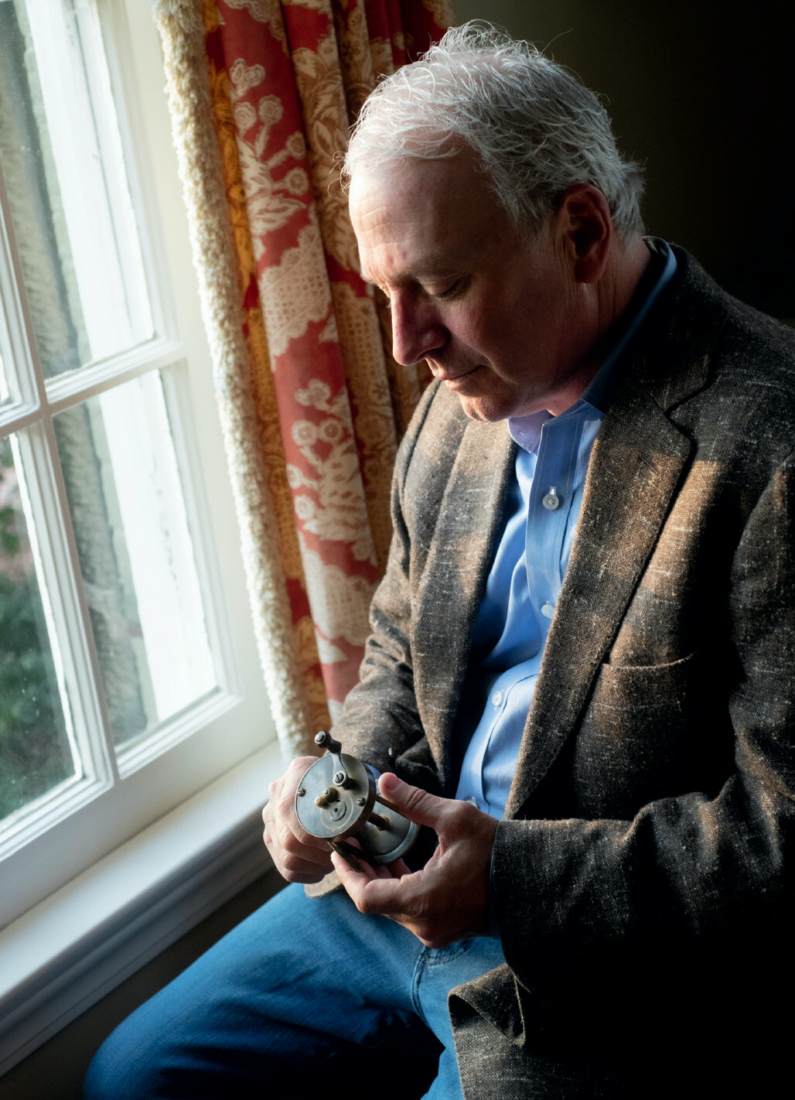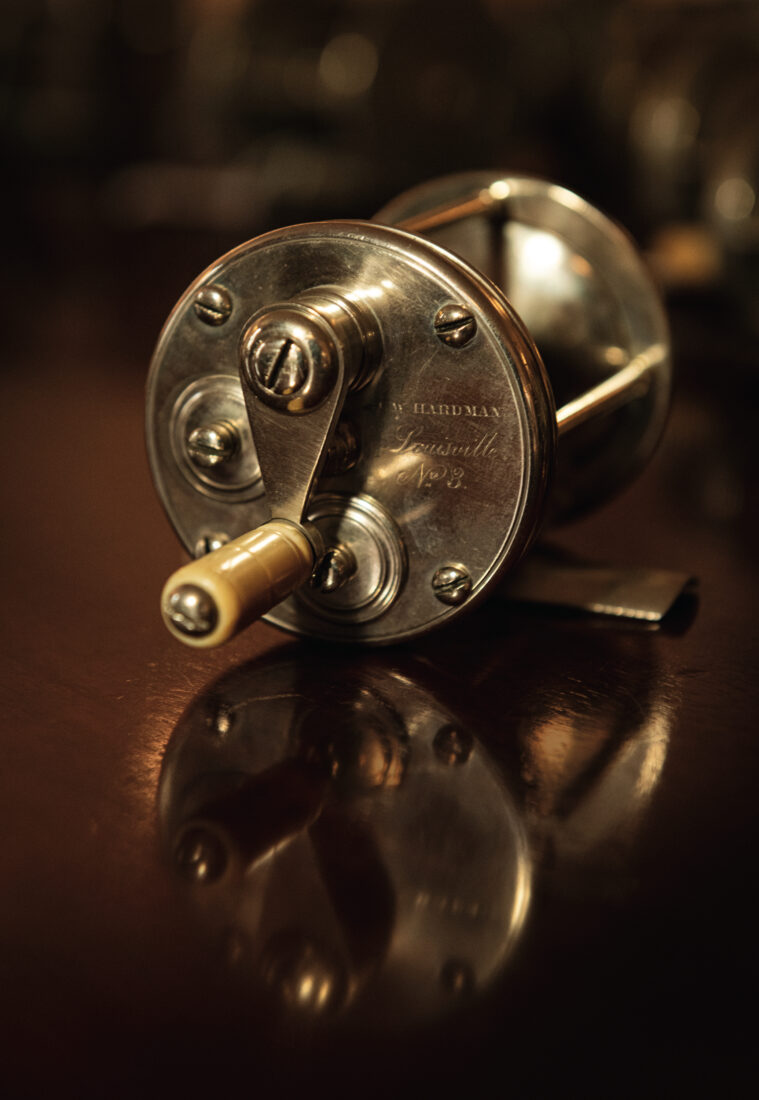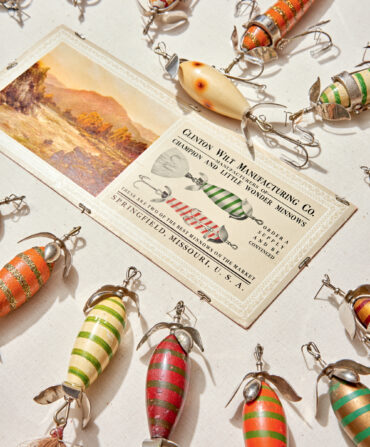In 1990, William Hinkebein, then a young salesman for a Louisville cocktail ingredient company, visited a friend’s newly purchased Kentucky farm. The men rummaged through the barns on the property, and in one of them, Hinkebein found a tackle box. He opened it up. “It was like a wave hit me,” he says. Within were some hand-painted lures and reels, all from the 1930s and ’40s. “It reminded me of fishing with my grandfather. I could smell the cigar smoke.”
The discovery sparked an obsession. As he traveled the South on sales calls, Hinkebein began visiting antique stores and attending estate sales, searching for vintage tackle. On one such trip, he came upon what would become his abiding passion: a Kentucky reel.
The Kentucky reel, made from roughly 1810 to 1948, plays a singular and significant role in the history and growth of the sport of angling. Its multiplying action (with a spool that typically turned four times for every crank) made it, essentially, the first reel that enabled an angler to ably cast bait and retrieve fish. (The reels used in America before its invention were all single-action or simple spools on a tin holder. The English had multipliers, but used them to retrieve line while trolling.) The reels gave rise to the popularity of recreational angling and begot the modern-day bait caster, the most popular reel used in bass fishing today.

But more than that, the reels were works of precision and beauty, handcrafted by a small tribe of artisans—jewelers, watchmakers, gunsmiths—who used brass or silver for the hardy bodies and embellished them with engravings and handles made of ivory or buffalo horn. And like the best bourbons, they were all made in Kentucky, a state replete with fish-filled waterways. They became a gentleman’s implement, owned by bourbon magnates such as Albert B. Blanton and George T. Stagg, and presented as gifts to presidents Grover Cleveland, William McKinley, and Theodore Roosevelt.

Because the reels were striking, sturdy, and handcrafted, collectors clamored for them off the bat. But they became much harder to find after the mass manufacturing of reels began in the 1910s; in the mid-1940s, the last maker closed up shop.
Hinkebein, who is fifty-nine, has now amassed approximately 150 reels, the world’s finest collection, according to Jim Schottenham, a well-regarded fishing museum curator based in Vermont. Among Hinkebein’s favorites are three made by George Snyder, a Paris, Kentucky, jeweler and silversmith who invented the Kentucky reel around 1810. As the story goes, Snyder, an avid bass angler, got his hands on an English multiplier and manufactured his own improved version. Besides Hinkebein’s trio, only eight other known Snyders exist. A buyer once offered Hinkebein “well over six figures” for one of them. (The reels typically range in price from a couple hundred dollars to tens of thousands.) “It’s like gold fever, man,” he says. “I know because I’ve got it myself.”
Hinkebein started his pursuit of Kentucky reels by perusing auctions and attending lure collector “meets.” He accumulated them slowly, adding one or two a year, and he nearly quit after someone stole five of his favorites from his car. But just a few years later, he spotted those in an auction catalogue. “I retrieved them and was back in the game,” he says.

The bulk of his pieces took some guile to procure. A man from Mount Sterling, Kentucky, frequently showed up at meets with Kentucky reels that other collectors didn’t even know existed. He “always wore overalls and had a beard like a member of ZZ Top,” Hinkebein says. “He was moody, and everyone was afraid of him, but he and I hit it off.” He urged the man to keep his collection intact and to keep it in Kentucky. He did both by selling it to Hinkebein.
The allure of the reels for Hinkebein goes beyond fishing. “This is my home state, and settlers came here because of the bounty of game and the rivers that teemed with fish,” he says. “These reels represent to me the then-frontier of a budding nation and all of the entrepreneurship, ingenuity, and craftsmanship of that time.” They also connect, he says, to the state’s other two big industries. “Kentucky’s water is high in calcium and magnesium and low in iron. It’s the same water that makes horses’ bones strong and bourbon taste so good.”
Hinkebein says there is one “Holy Grail” Kentucky reel for him out there, made by the nineteenth-century Frankfort gunsmith James L. Sage. He located it only recently, and reached out to the owner to ask if he could photograph it. “The owner called and said he ‘wasn’t interested in selling’ and hung up,” Hinkebein says. “But I haven’t given up just yet.”









